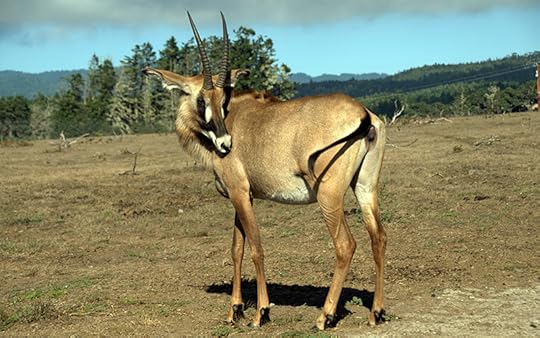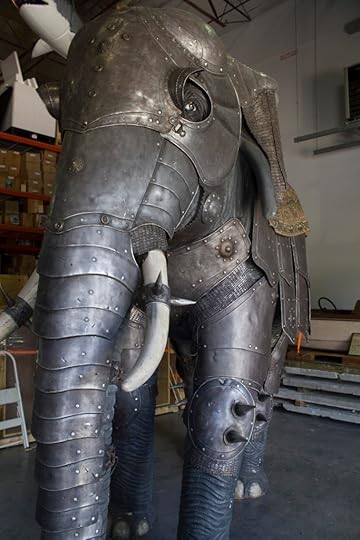Ripley Entertainment Inc.'s Blog, page 462
August 15, 2016
Beaver Incorporated Man’s Prosthetic Leg in its Dam
Featured in Ripley's Believe It or Not!

During a day of canoeing, two men found a prosthetic leg sticking out of a beaver dam. They found the leg’s owner on Craigslist and returned it.
Elliot Fuller and Jason Franklin went canoeing on August 4th
They were excited when they came across a real beaver dam
As they got closer to the dam, they saw what was clearly a leg sticking out of the structure
Initially, they thought that they had stumbled across a dead body
When they were close enough to pull it out of the dam, they saw it was a prosthetic leg
They took it home and decided to search Craigslist to see if anyone was missing it
They saw a post from Mark Warner in Green Bay saying he lost his prosthetic leg while fishing
When they returned it to him, he gave them a $50 reward for finding it
MINI BION
“BIONs” – short for Believe It or Not – is the word we use at Ripley’s to refer to anything that is unbelievable and worthy to become part of Ripley’s lore and collection.
Priceless Apollo 11 Artifact was Accidentally Sold at Auction
Featured in Ripley's Believe It or Not!

A priceless artifact from the Apollo 11 moon landing got a price tag of $995 at an accidental auction. The artifact’s “priceless” status being challenged by the highest bidder wouldn’t be so surprising if it weren’t for the fact that it was never meant to be sold in the first place.
But how does an important part of Americana go from its rightful place in a museum to a new home in a private collection? Through a mashup of criminal action and slight ineptitude, of course.
The Apollo 11 Artifact
 Whether you believe in the first moon landing or not, the story is legend. In 1969, Neil Armstrong and Buzz Aldrin became the first people to set foot on the moon.
Whether you believe in the first moon landing or not, the story is legend. In 1969, Neil Armstrong and Buzz Aldrin became the first people to set foot on the moon.
The event, televised across the country, was the culmination of years of research and scientific discoveries, and a major turning point in the space race.
While on the moon, Buzz and Neil collected samples. Those samples were, of course, kept in a bag. That bag is the current source of all this tension.
Some years after the bag returned to Earth, it was loaned out by Nasa to the Kansas Cosmosphere and Space Center as a new exhibit. In the early 2000s, Max Ary was the director of the Cosmosphere. Some evidence supports the accusation that Mr. Ary had sticky fingers.
In 2003, Ary’s garage was searched by the authorities and they found the lunar bag among his personal possessions. Ary had allegedly stolen the bag from the Cosmosphere.
The Duplication

Neil Armstrong working on the moon
Ary’s deception wasn’t the only factor in the bag’s original sale. The Apollo 11 bag was not the only bag he had in his possession. There was another bag from the Apollo 17 mission. Due to a clerical error, these two bags had been given the same inventory identification number.
Ary sold the Apollo 17 bag in 2001 for $24,150. Investigators recovered it, but the ID number mix up could have left them unsure about which bag they had. This could have led to the older bag being lost longer than necessary.
Luckily for NASA, Nancy Carlson bought the Apollo 11 bag for $995 and sent it in to be verified by experts. Unluckily for Nancy, those experts took it upon themselves to keep the bag.
Now Nancy is suing NASA and demanding they return what she views as being rightfully hers. NASA is requesting that a judge void the sale and refund the money, allowing them to keep the artifact.
Source: Priceless Apollo 11 Artifact was Accidentally Sold at Auction
CARTOON 08-15-2016
August 14, 2016
CARTOON 08-14-2016
August 13, 2016
CARTOON 08-13-2016
August 12, 2016
The Skunk Cabbage is a Plant that Creates its Own Heat
Featured in Ripley's Believe It or Not!

The skunk cabbage of North America generates its own heat, up to 72°F (22°C), through the process of thermogenesis.
The skunk cabbage gets its name from the odor released from breaking one of its leaves
The cabbage grows in ice and snow
Its ability to create its own heat helps to melt the snow and allows the plant to flower in late winter
Studies show that the heat of the plant may also aid in spreading its odor to attract pollinators
MINI BION
“BIONs” – short for Believe It or Not – is the word we use at Ripley’s to refer to anything that is unbelievable and worthy to become part of Ripley’s lore and collection.
Source: The Skunk Cabbage is a Plant that Creates its Own Heat
Bokdrol Spoeg, or The Sport of Antelope Dung Spitting
Featured in Ripley's Believe It or Not!

Bokdrol Spoeg is a South African sport where competitors spit antelope dung as far as possible.
Each contestant selects a pellet of antelope dung
The dung is placed in the mouth and spat as far as possible
The farthest distance is the winner
The reasons behind this “sport” seem to be more about tricking people to put antelope poop in their mouth than about actual competition
MINI BION
“BIONs” – short for Believe It or Not – is the word we use at Ripley’s to refer to anything that is unbelievable and worthy to become part of Ripley’s lore and collection.
Source: Bokdrol Spoeg, or The Sport of Antelope Dung Spitting
Unboxing World Elephant Day
Featured in Ripley's Believe It or Not!

In This Episode
Elephants have played some odd roles in history, but nothing is quite as unbelievable as their role as TANKS on ancient battlefields! In honor of World Elephant Day…
Today: Elephant Armor
Share & Subscribe
If you liked the show, please share it with your peeps. Remember to SUBSCRIBE to our channel to stay BION-informed!


Ripley’s found this 18th-century Indo-Persian suit of elephant armor in Stratford-upon-Avon, England. This suit would fit an elephant standing over 12 feet high, and with the howdah—the carriage that sits on the elephant’s back—the exhibit is 16 feet tall overall!
Elephants have been trained for centuries to do man’s calling, everything from moving logs to walking on tightropes, to fighting battles. First employed in India, the practice of using elephants on the battlefield spread out across south-east Asia and westwards into the Mediterranean.
The first use of elephants on the battlefield occurred at Alexander the Great’s Battle of Gaugamela (331 BCE), when the Persians deployed fifteen elephants. Inspired by Hannibal’s use of elephants against the Roman Empire, the Mogul Emperors of India also introduced armored elephants as a weapon of war in the 18th century. Dressed in full armor, these huge animals were virtually invincible, and helped regional rajahs conquer even the most fortified towns and villages.
Nowadays, elephants play it safe, but still have some peculiar uses—one of our favorites, elephant polo!
Embed from Getty Images
Elephant Polo
The unusual sport of elephant polo was first played in India in the early 20th century, but the modern game originated in Nepal in 1983 where it is now a registered Olympic sport. Tournaments, played in Trunk Ball Thailand, Nepal and Sri Lanka, draw in 12 international teams every year from five different continents and are organized by the World Elephant Polo Association.
Each match involves 28 elephants, each with two players on its back. The game is played on an area the size of a football field and players wield polo sticks that are 6 to 9 feet in length!
The Rules:
● Elephants must not lie down in front of the goalmouth
● An elephant may not pick up a ball with its trunk during play
● Elephants must not step on the ball
● No team may have more than three elephants on one half of the field at any given time
● Sex, age or size of the elephant does not matter
● Men may use only one hand to hold onto the elephant, women may use two
Embed from Getty Images
Source: Unboxing World Elephant Day
Spotted Salamanders Are the Only Animals to Photosynthesize
Featured in Ripley's Believe It or Not!

Spotted Salamanders are the only vertebrates capable of photosynthesis, creating oxygen from light-absorbing algae in their cells.
Spotted Salamanders lay their eggs in a thick jelly to stop them from drying out
This jelly stops oxygen from reaching the embryos
The embryos have a symbiotic relationship with a kind of algae
The algae produces oxygen from sunlight, and the embryos process it and produce carbon dioxide for the algae
MINI BION
“BIONs” – short for Believe It or Not – is the word we use at Ripley’s to refer to anything that is unbelievable and worthy to become part of Ripley’s lore and collection.
Source: Spotted Salamanders Are the Only Animals to Photosynthesize
CARTOON 08-12-2016
Ripley Entertainment Inc.'s Blog
- Ripley Entertainment Inc.'s profile
- 52 followers







